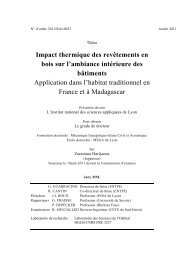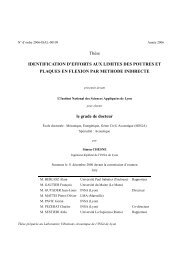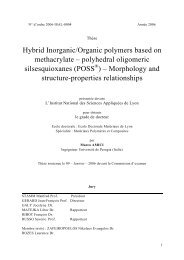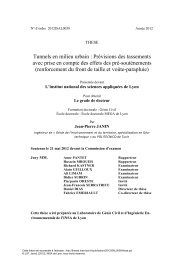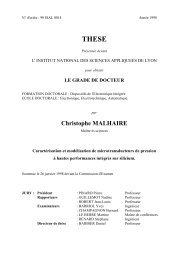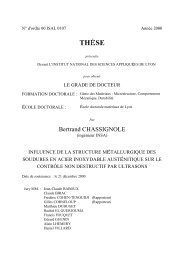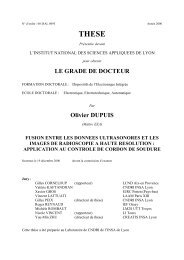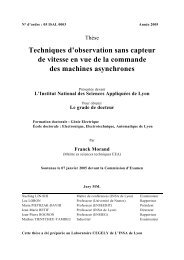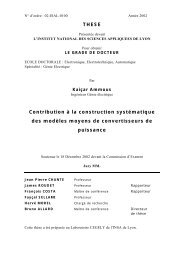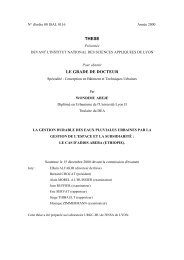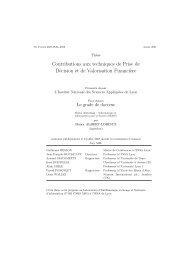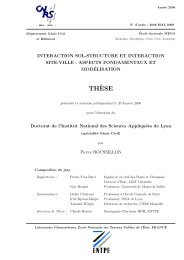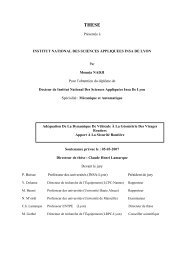- Page 1:
N° d’ordre 2011ISAL0018 Année 2
- Page 5 and 6:
Remerciements Je voudrais d’abord
- Page 7:
Traitement et analyse de séries ch
- Page 11:
Table des matières
- Page 14 and 15:
Tables des matières 3.2.1 Test de
- Page 16 and 17:
Tables des matières CHAPITRE 9 : P
- Page 18 and 19:
Tables des matières 14.3.4 Calcul
- Page 21:
Liste des abréviations DCO Demande
- Page 24 and 25:
Liste des variables DTS E f f -1 du
- Page 26 and 27:
Liste des variables S Pond somme po
- Page 29:
Introduction générale 1
- Page 32 and 33:
Introduction générale et al. (200
- Page 34 and 35:
Introduction générale Structure d
- Page 37:
Partie 1 : La modélisation de la q
- Page 40 and 41:
Partie 1 - Chapitre 1 : Introductio
- Page 42 and 43:
Partie 1 - Chapitre 1 : Introductio
- Page 45 and 46:
Partie 1 - Chapitre 2 : Approches d
- Page 47 and 48:
Partie 1 - Chapitre 2 : Approches d
- Page 49 and 50:
Partie 1 - Chapitre 2 : Approches d
- Page 51 and 52:
Partie 1 - Chapitre 2 : Approches d
- Page 53 and 54:
Partie 1 - Chapitre 2 : Approches d
- Page 55 and 56:
Partie 1 - Chapitre 2 : Approches d
- Page 57:
Partie 1 - Chapitre 2 : Approches d
- Page 60 and 61:
Partie 1 - Chapitre 3 : Choix des a
- Page 62 and 63:
Partie 1 - Chapitre 3 : Choix des a
- Page 65:
Partie 2 Test des modèles et incer
- Page 68 and 69:
Partie 2 - Test des modèles et inc
- Page 70 and 71:
Partie 2 - Chapitre 4 : Le concept
- Page 72 and 73:
Partie 2 - Chapitre 4 : Le concept
- Page 74 and 75:
Partie 2 - Chapitre 4 : Le concept
- Page 76 and 77:
Partie 2 - Chapitre 4 : Le concept
- Page 78 and 79:
Partie 2 - Chapitre 4 : Le concept
- Page 80 and 81:
Partie 2 - Chapitre 4 : Le concept
- Page 83 and 84:
Partie 2 - Chapitre 5 : Les méthod
- Page 85 and 86:
Partie 2 - Chapitre 5 : Les méthod
- Page 87 and 88:
Partie 2 - Chapitre 5 : Les méthod
- Page 89 and 90:
Partie 2 - Chapitre 5 : Les méthod
- Page 91 and 92:
Partie 2 - Chapitre 5 : Les méthod
- Page 93 and 94:
Partie 2 - Chapitre 5 : Les méthod
- Page 95 and 96:
Partie 2 - Chapitre 5 : Les méthod
- Page 97 and 98:
Partie 2 - Chapitre 5 : Les méthod
- Page 99 and 100:
Partie 2 - Chapitre 5 : Les méthod
- Page 101 and 102:
Partie 2 - Chapitre 5 : Les méthod
- Page 103 and 104:
Partie 2 - Chapitre 5 : Les méthod
- Page 105 and 106:
Partie 2 - Chapitre 5 : Les méthod
- Page 107 and 108:
Partie 2 - Chapitre 5 : Les méthod
- Page 109 and 110:
Partie 2 - Chapitre 5 : Les méthod
- Page 111 and 112:
Partie 2 - Chapitre 5 : Les méthod
- Page 113 and 114:
Partie 2 - Chapitre 5 : Les méthod
- Page 115 and 116:
Partie 2 - Chapitre 5 : Les méthod
- Page 117 and 118:
Partie 2 - Chapitre 6 : Test des mo
- Page 119 and 120:
Partie 2 - Chapitre 6 : Test des mo
- Page 121 and 122:
Partie 2 - Chapitre 6 : Test des mo
- Page 123 and 124:
Partie 2 - Chapitre 6 : Test des mo
- Page 125 and 126:
Partie 2 - Chapitre 6 : Test des mo
- Page 127:
Partie 2 - Chapitre 6 : Test des mo
- Page 131:
Partie 3 Construction de la base de
- Page 135 and 136:
Partie 3 - Chapitre 7 : Présentati
- Page 137 and 138:
Partie 3 - Chapitre 7 : Présentati
- Page 139 and 140:
Partie 3 - Chapitre 7 : Présentati
- Page 141 and 142:
Partie 3 - Chapitre 7 : Présentati
- Page 143 and 144:
Partie 3 - Chapitre 8 : Traitement
- Page 145 and 146:
Partie 3 - Chapitre 8 : Traitement
- Page 147 and 148:
Partie 3 - Chapitre 8 : Traitement
- Page 149 and 150:
Partie 3 - Chapitre 8 : Traitement
- Page 151 and 152:
Partie 3 - Chapitre 8 : Traitement
- Page 153 and 154:
Partie 3 - Chapitre 9 : Présentati
- Page 155 and 156:
Partie 3 - Chapitre 9 : Présentati
- Page 157 and 158:
Partie 3 - Chapitre 9 : Présentati
- Page 159 and 160:
Partie 3 - Chapitre 9 : Présentati
- Page 161 and 162:
Partie 3 - Chapitre 9 : Présentati
- Page 163 and 164:
Partie 3 - Chapitre 9 : Présentati
- Page 165 and 166:
Partie 3 - Chapitre 9 : Présentati
- Page 167 and 168:
Partie 3 - Chapitre 9 : Présentati
- Page 169 and 170:
Partie 3 - Chapitre 9 : Présentati
- Page 171:
Partie 3 - Chapitre 9 : Présentati
- Page 175:
Partie 4 - Analyse des données Int
- Page 178 and 179:
Partie 4 - Chapitre 10 : Variabilit
- Page 180 and 181:
Partie 4 - Chapitre 10 : Variabilit
- Page 182 and 183:
Partie 4 - Chapitre 10 : Variabilit
- Page 184 and 185:
Partie 4 - Chapitre 10 : Variabilit
- Page 186 and 187:
Partie 4 - Chapitre 10 : Variabilit
- Page 188 and 189:
Partie 4 - Chapitre 10 : Variabilit
- Page 190 and 191:
Partie 4 - Chapitre 10 : Variabilit
- Page 192 and 193:
Partie 4 - Chapitre 11 : Estimation
- Page 194 and 195:
Partie 4 - Chapitre 11 : Estimation
- Page 196 and 197:
Partie 4 - Chapitre 11 : Estimation
- Page 198 and 199:
Partie 4 - Chapitre 11 : Estimation
- Page 200 and 201:
Partie 4 - Chapitre 11 : Estimation
- Page 202 and 203:
Partie 4 - Chapitre 11 : Estimation
- Page 205 and 206:
Partie 4 - Chapitre 12 : Variabilit
- Page 207 and 208:
Partie 4 - Chapitre 12 : Variabilit
- Page 209 and 210:
Partie 4 - Chapitre 12 : Variabilit
- Page 211 and 212:
Partie 4 - Chapitre 12 : Variabilit
- Page 213 and 214:
Partie 4 - Chapitre 12 : Variabilit
- Page 215 and 216:
Partie 4 - Chapitre 12 : Variabilit
- Page 217 and 218:
Partie 4 - Chapitre 12 : Variabilit
- Page 219 and 220:
Partie 4 - Chapitre 12 : Variabilit
- Page 221 and 222:
Partie 4 - Chapitre 12 : Variabilit
- Page 223 and 224:
Partie 4 - Chapitre 12 : Variabilit
- Page 225 and 226:
Partie 4 - Chapitre 12 : Variabilit
- Page 227 and 228:
Partie 4 - Chapitre 12 : Variabilit
- Page 229 and 230:
Partie 4 - Chapitre 12 : Variabilit
- Page 231 and 232:
Partie 4 - Chapitre 12 : Variabilit
- Page 233 and 234:
Partie 4 - Chapitre 12 : Variabilit
- Page 235 and 236:
Partie 4 - Chapitre 12 : Variabilit
- Page 237 and 238:
Partie 4 - Chapitre 12 : Variabilit
- Page 239 and 240:
Partie 4 - Analyse des données : C
- Page 241:
Partie 5 Choix des modèles et mét
- Page 245 and 246:
Partie 5 - Chapitre 13 : Modèles d
- Page 247 and 248:
Partie 5 - Chapitre 13 : Modèles d
- Page 249 and 250:
Partie 5 - Chapitre 13 : Modèles d
- Page 251 and 252:
Partie 5 - Chapitre 13 : Modèles d
- Page 253 and 254:
Partie 5 - Chapitre 13 : Modèles d
- Page 255 and 256:
Partie 5 - Chapitre 13 : Modèles d
- Page 257 and 258:
Partie 5 - Chapitre 13 : Modèles d
- Page 259:
Partie 5 - Chapitre 13 : Modèles d
- Page 262 and 263:
Partie 5 - Chapitre 14 : Modèles d
- Page 264 and 265:
Partie 5 - Chapitre 14 : Modèles d
- Page 266 and 267:
Partie 5 - Chapitre 14 : Modèles d
- Page 268 and 269:
Partie 5 - Chapitre 14 : Modèles d
- Page 270 and 271:
Partie 5 - Chapitre 14 : Modèles d
- Page 272 and 273:
Partie 5 - Chapitre 14 : Modèles d
- Page 274 and 275:
Partie 5 - Chapitre 14 : Modèles d
- Page 276 and 277:
Partie 5 - Chapitre 14 : Modèles d
- Page 278 and 279:
Partie 5 - Chapitre 14 : Modèles d
- Page 280 and 281:
Partie 5 - Chapitre 15 : Méthodolo
- Page 282 and 283:
Partie 5 - Chapitre 15 : Méthodolo
- Page 284 and 285:
Partie 5 - Chapitre 15 : Méthodolo
- Page 286 and 287:
Partie 5 - Chapitre 15 : Méthodolo
- Page 288 and 289:
Partie 5 - Chapitre 15 : Méthodolo
- Page 291:
Partie 6 - Résultats des tests Int
- Page 294 and 295:
Partie 6 - Chapitre 16 : Test des m
- Page 296 and 297:
Partie 6 - Chapitre 16 : Test des m
- Page 298 and 299:
Partie 6 - Chapitre 16 : Test des m
- Page 300 and 301:
Partie 6 - Chapitre 16 : Test des m
- Page 302 and 303:
Partie 6 - Chapitre 16 : Test des m
- Page 304 and 305:
Partie 6 - Chapitre 16 : Test des m
- Page 306 and 307:
Partie 6 - Chapitre 16 : Test des m
- Page 309 and 310:
Partie 6 - Chapitre 17 : Test des m
- Page 311 and 312:
Partie 6 - Chapitre 17 : Test des m
- Page 313 and 314:
Partie 6 - Chapitre 17 : Test des m
- Page 315 and 316:
Partie 6 - Chapitre 17 : Test des m
- Page 317 and 318:
Partie 6 - Chapitre 17 : Test des m
- Page 319 and 320:
Partie 6 - Chapitre 17 : Test des m
- Page 321 and 322:
Partie 6 - Chapitre 17 : Test des m
- Page 323 and 324:
Partie 6 - Chapitre 17 : Test des m
- Page 325 and 326:
Partie 6 - Chapitre 17 : Test des m
- Page 327 and 328:
Partie 6 - Chapitre 17 : Test des m
- Page 329 and 330:
Partie 6 - Chapitre 17 : Test des m
- Page 331 and 332:
Partie 6 - Chapitre 17 : Test des m
- Page 333 and 334:
Partie 6 - Chapitre 17 : Test des m
- Page 335 and 336:
Partie 6 - Chapitre 17 : Test des m
- Page 337 and 338:
Partie 6 - Chapitre 17 : Test des m
- Page 339:
Partie 6 - Chapitre 17 : Test des m
- Page 343 and 344: Conclusion générale Retour sur la
- Page 345 and 346: Conclusion générale évidence la
- Page 347 and 348: Conclusion générale données acqu
- Page 349: Bibliographie 321
- Page 352 and 353: Bibliographie Bertrand-Krajewski J.
- Page 354 and 355: Bibliographie Bujon G. (1988). Pré
- Page 356 and 357: Bibliographie Dorval F. 2010. Const
- Page 358 and 359: Bibliographie Gupta K. et Saul Adri
- Page 360 and 361: Bibliographie Kuczera G. et Parent
- Page 362 and 363: Bibliographie Muschalla D., Schneid
- Page 364 and 365: Bibliographie monitoring data. Proc
- Page 366 and 367: Bibliographie Vrugt J. et Bouten W.
- Page 369: Annexes Annexe 1 Métadier M. et Be
- Page 372 and 373: Annexes INTRODUCTION Les exigences
- Page 374 and 375: Annexes correspondante (équation 3
- Page 376 and 377: Annexes Figure 26. Relations [MES]-
- Page 378 and 379: Annexes avec m Xi le flux de pollua
- Page 380 and 381: Annexes MES 2000 Masses événement
- Page 382 and 383: Annexes capteurs, utilisation des r
- Page 384 and 385: Annexes ANNEXE A Cette annexe prés
- Page 387 and 388: Annexes From mess to mass: a method
- Page 389 and 390: Annexes Sensor uncertainties. Calib
- Page 391: Annexes terminated. Else Test 2 is
- Page 395 and 396: Annexes a b c 1500 TSS (kg) COD (kg
- Page 397 and 398: Annexes test and apply the enhanced
- Page 399 and 400: Annexes Assessing dry weather flow
- Page 401 and 402: Annexes t f 2 2 2 2 2 2 u( M X )
- Page 403 and 404: Annexes M M M X _ WW X X _ DW 2 (
- Page 405 and 406: Annexes class 4. This regression co
- Page 407 and 408: Annexes The analysis of the evoluti
- Page 409: Annexes Lacour C., Joannis C. and C



